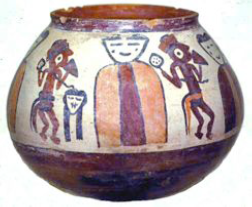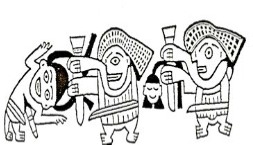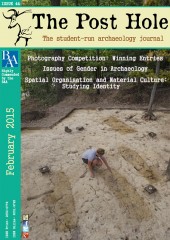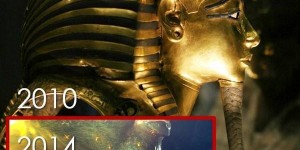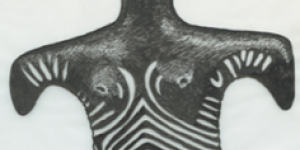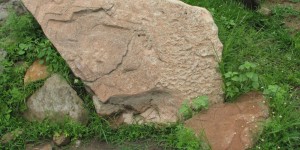Introduction
There are many similarities among the pre-Columbian cultures of South America. Meaning an analysis between one early culture (Chinchorros) and two closely linked cultures (Paracas and Nascas) is necessary; firstly to assess similarities which are uniform through time and secondly to investigate how burial practices progress in a single cultural group. This paper will analyse each individual culture and compare the three looking for similarities and linear progressions. The first similarity investigated is the continual use of decapitation, which is consistent in all three groups (Arriaza 1995; Arriaza et al. 2005; Arriaza et al. 2008 51-53; Aufderheide et al. 1993; Brown et al. 1993; DeLeonardis 2000; Krudson et al. 2009; Peters 2000; Proulx 2001; Proulx 2008, 572-580; Proulx 1999; Santoro et al. 2012; Silverman 2002: 170, 202). Another is the use of shrouds, either textiles or simpler vegetable and camelid wrappings, as well as other offerings and grave goods (Arriaza 1995; Arriaza et al. 2005; Arriaza et al. 2008, 53; Aufderheide et al. 1993; DeLeonardis 2000; Peters 2000; Proulx 2008, 565-572; Proulx 1993; Santoro et al. 2012; Silverman 2002: 174, 202; Silverman 2002; Stewart 1943). The third is the notion of social stratification (Arriaza 1995; Arriaza et al. 2005; Arriaza et al. 2008, 51-53; Aufderheide et al. 1993; Brown et al. 1993; DeLeonardis 2000; Krudson et al. 2009; Peters 2000; Proulx 2001; Proulx 2008, 572-580; Proulx 1999; Santoro et al. 2012; Sepúlveda 2014; Silverman 2002: 170, 202).
Chinchorro mortuary practice
Social stratification
Chinchorro mummification has five distinct forms: black, red, mud, bandage and natural (Arriaza 1995; Arriaza et al. 2005; Arriaza et al. 2008:51; Santoro et al. 2012; Sepúlveda et al. 2014. Which citations refer to which form of mummification?). The evolution of these methods of preservation is unclear and it has been argued that it was purely egalitarian; however there is evidence of social stratification at death (Arriaza 1995; Arriaza et al. 2005; Sepúlveda et al. 2014). This division is clear in the later stages of the Chinchorro culture, with the greater use of grave goods in varied abundance between 2000-1500 BC. Conversely, it is also visible in the earliest stages (6000-5000 BC) of artificial mummification, (Arriaza 1995; Arriaza et al. 2005; Arriaza et al. 2008, 50). Mummification began as a tool to console grieving parents who lost their children due to arsenic in drinking water and hence the method was strictly used on children during the earliest phases of the Chinchorro practices (Arriaza 2008, 51; Santoro et al. 2012; Sepúlveda et al. 2014) This selective mummification is clearly seen from Camarones 14 and 17 where children were mummified (C-3 and C-4) and adults were not (Arriaza 1995; Aufderheide et al. 1993). Therefore, children were arguably the most important in the culture. This does not suggest a hierarchal stratification in the culture, but only stratification at death due to grief.
A hierarchy is discernible in the later phases of black mummification. As mummification expanded as a cultural tradition, it seems that there was an established egalitarian mortuary practice with little variation (Arriaza 1995; Arriaza et al. 2005; Arriaza et al. 2008, 51; Santoro et al. 2012; Sepúlveda et al. 2014). However, this was due to the economic stability of the culture. This can be easily seen in Sepúlveda et al. (2014) where established trade networks with southern Peru and the highlands were used to obtain the manganese minerals with a copper trace for use on black mummies. The scarcity of these materials then led to a shift towards the use of more readily available red pigments: this shift is seen in the Tarapacá Universidad mummy which is dated 2800 ± 155 BC, which has red and yellow ochre bands on top of a single layer of manganese instead of the more common five coatings of manganese (Arriaza 1995; Sepúlveda 2014). This change led to the use of the black pigments being reserved for the faces of mummies and for use on children (Arriaza 1995; Arriaza et al. 2005; Arriaza et al. 2008, 51; Santoro et al. 2012; Sepúlveda et al. 2014). Consequently, Arriaza’s (1995) suggestion that social stratification was non-existent, due to the majority (71%) of mummies being artificially mummified, can be seen to be inaccurate. It is not whether they were mummified, but how they were mummified that determines social stratification. This change in mummification practice, from black to red, then led to increased variation in mortuary practices. Natural mummification was on the rise due to the lack of resources to properly mummify the dead, and different methods were used to display status rather than black mummification (Arriaza 1995; Sepúlveda et al. 2014). The use of bandages and mud coatings particularly display opposite ends of a hierarchy. The use of a bandage coating, which shares features of both black and red mummification, clearly was a show of status; these mummies would have required considerable effort and expense to produce, both those using black pigments and those using red pigments (black showing an even higher status) (Arriaza 1995; Arriaza et al. 2008, 51-53; Aufderheide et al. 1993; Santoro et al. 2012; Sepúlveda et al. 2014). This is then contrasted with mud coated mummies, which show a very simplistic method of preservation: using a sandy cement-like mixture to encase the body, although there is variation on whether they were eviscerated or not (Arriaza 1995; Arriaza et al. 2008, 51-53; Aufderheide et al. 1993; Santoro et al. 2012; Sepúlveda et al. 2014). This clearly shows that social stratification was an evident motion in society provoking more and less elaborate forms of mummification, which were influenced by economic stressors through the Chinchorro period.
Decapitation
It is important to note that decapitation originated in this period. Decapitation was a vital part of the mummification process, in the production of both black and red mummies, to allow extraction of the brain through the foramen magnum (Arriaza 1995; Arriaza et al. 2005; Arriaza et al. 2008, 51; Aufderheide et al. 1993; Santoro et al. 2012; Sepúlveda et al. 2014). Although the ritual or practical purposes of decapitation are not fully understood, it is still crucial to acknowledge that the origin occurred here, particularly when comparing the Chinchorros with the Paracas and Nasca cultures. The use of artificial heads, which was another factor of considerable variation in the treatment of corpses, also originated in this period (Aufderheide et al. 1993). There is no evidence as to what happened to the original head, however it may be postulated that veneration or use in ritual is probable, as in the practices of the other cultures.
Shrouds
The use of shrouds by the Chinchorros occurred as early as Acha Man (7000 BC), who was found with remains of a tortora reed mat covering part of his face; this is believed to have covered at least the whole head (Aufderheide et al. 1993). This type of shroud continued to be used until the end of the Chinchorros (1500 BC), however there was variation in the bandage mummies, where the body’s own skin and animal hides were used to wrap the body (Santoro et al. 2012). The continual use of shrouds through the periods of focus makes this a highly relevant subject for comparison.
Paracas mortuary practices
Social stratification
The mortuary stratification of the Paracas can be divided into three main groups: Caverns, Necropolis and Ocucaje (Peters 2000; Proulx 2008; Stewart 1943). The Caverns were bottle shaped pit tombs where multiple burials were placed in the natural landscape of Cerro Colorado, some with stone-lined antechambers and roofs constructed from organic material (Peters 2000; Stewart 1943). This was the simplest of burial methods, requiring no evisceration and, due to the high salinity of the soil, it is argued that no special treatment was needed and only smoking was used for artificial preservation (Burger 2009; Stewart 1943). However, the methods used in caverns may be oversimplified. The presence of a black substance on bones and tissue indicates the use of a preservative (Stewart 1943). This shows there was an element of complexity in the treatment of bodies. Less structured bundles also support cavern burials being low class (Peters 2000).
Necropolis burials are located in abandoned domestic structures; these included more grave goods, better structured bundles and more mummies, which is clear from sites with up to 429 mummies (Peters 2000; Proulx 2008; Stewart 1943). The Necropolis burials are prepared in a more complex manner, with the viscera and muscles removed (Stewart 1943). The brain, as with the method practiced by the Chinchorros, was removed through the foramen magnum, thereby suggesting an influence or perhaps linear progression from earlier, possibly Chinchorro, societies (Stewart 1943). The Ocucaje burials are a denomination of Necropolis burials. Key differences are adobe walls, two chambers and a greater amount of grave goods (Peters 2000). These differences in mortuary practice show a clear continuation of social stratification from earlier cultures.
One key difference to note is that unlike the Chinchorros, who developed social stratification due to a lack of resources and allocated materials based on an emotional hierarchy (with children at the top), the Paracas developed stratification at death based upon prestige during life. This is clear because of the demographics of the assemblages and the differences of sites such as Juan Pablo, where they were buried in simple pits, and the Necropolis (Strong 1957). The Cavern burials are a more general area of burial, showing both genders and multiple ages, whereas the Ocucaje burials are always elderly men between the age of 50 and 70 (Peters 2000). This demonstrates a very specific group was being selected for burial in these areas. This group also shows distinctive outer garments, often worn by supernatural creatures in iconography, which suggests a specific role in society (Peters 2000; Stewart 1943). Therefore at this period in time, stratification at death had a totally different motive based on societal structure and was not based on grief as with the early Chinchorros. Instead it is an expansion on the early stratification seen after the red mummies.
Textiles
The textiles used vary based on the funerary groupings explained above. In Cavern burials the textiles were loose, simple and less abundant leading to smaller and less shaped bundles (Proulx 2008; Peters 2000). However the more extravagant textiles from the Necropolis and the Ocucaje tell us a lot about the culture. It is important to recognise that textiles used during life were incorporated into the bundles, but that there were also textiles produced specifically for the dead (Peters 2000). Most revealing of all, regarding customs of the dead, is the iconography of occult beings and trophy heads on the textiles (Proulx 1999). The Paracas are responsible for the earliest depiction of trophy heads in Peru (Proulx 1999; Proulx 2001; Proulx 2008, 571), and in this regard the textiles show a large cross-over with Nasca pottery (Silverman 2002).
Decapitation
Physical decapitation in the Paracas is mentioned above as a method to extract the brain via the foramen magnum, however due to the iconography it is clear that this was not only a method of preservation. Due to the similarities with the Nasca, this will be discussed further below.
Nasca mortuary practices
Decapitation
The Nasca were the culture most focused on ritual decapitation, with 21.5% of Nasca 6 motifs depicting trophy heads (Brown et al. 1993; Knudson et al. 2009; Proulx 1999; Proulx 2001; Proulx 2008, 572-580; Silverman 2002, 170; Silverman 2002). The trophy heads have specific characteristics similar to the Paracas trophy heads, such as the use of a carrying rope through the forehead, stuffing the eyes with cotton and removal of the brain through the foramen magnum (Brown et al. 1993; DeLeonardis 2000; Knudson et al. 2009; Proulx 1999; Proulx 2001; Proulx 2008, 572-580; Silverman 2002). There is distinct evidence of ritual from small cut marks on the scalp, which may have been a ritual bloodletting (Brown et al. 1993; Proulx 1999). However, the most convincing evidence is the appearance of vegetables either as offerings to heads or morphing into trophy heads in iconography (Knudson et al. 2009; Proulx 1999; Proulx 2001; Proulx 2008, 572-580; Silverman 2002, 170). Figure 1 shows a trophy head being presented to a bundle and figure 2 shows the taking of trophy heads (Proulx 2001). It is important to notice on these motifs that the trophies are smiling, therefore the actual taking of trophy heads was not seen as brutal. Notably, trophy head taking was linked to social prestige, with warriors and political officers often depicted carrying heads (Knudson et al. 2009; Proulx 1999; Proulx 2001; Proulx 2008, 572-580; Silverman 2002). Thus it can be argued that trophy heads were an important factor in social structure.
There is a distinct change in the deposition of trophy heads, with a shift from singular deposition to caching (Brown et al. 1993; Knudson et al. 2009; Proulx 1999; Proulx 2001; Proulx 2008, 572-580; Silverman 2002). This may represent a shift from respecting the individuals to more forceful collection. This theory is also supported by evidence for ritual warfare (DeLeonardis 2000; Proulx 1999; Proulx 2001; Proulx 2008, 572-580).
Similar to the Paracas with their textile false heads and the Chinchorro clay reconstructions, the Nasca used false heads (DeLeonardis 2000; Proulx 1999; Proulx 2008, 580). These come in many different forms, ranging from the limestone replacement of PV62D13, to textile replacements seen at Ubbelohde Doering, to ceramic replacements seen at Aja B cemetery (DeLeonardis 2000). Once again this shows a link, not only to the Paracas but to the Chinchorros as well.
Conclusion
The use of decapitation, shrouds or textiles, and the stratification of the dead are three clear similarities between the three cultures discussed. The use of decapitation as a feature of the mummification process and the eventual ritualism of the method can be seen as a progressive development in the cultures. The use of shrouds is a method that was exaggerated by the later cultures. Social stratification clearly progressed through the Chinchorro period, and expanded into everyday life among the later cultures, leading to stratification based on social position rather than grief. Therefore it is clear that there are similarities between the Chinchorro, the Paracas and the Nasca and that the progression between the two later cultures was stimulated by economic development (the use of ceramics) and the increasing ritualisation of methods of mummification.
References
- Arriaza, B. T. (1995). Chinchorro bioarchaeology: chronology and mummy seriation. Latin American Antiquity. 35-55.
- Arriaza, B., Standen, V., Doubrava, M. and Haas, H. (2005). Differential Mortuary Treatment among the Andean Chinchorro Fishers: Social Inequalities or In Situ Regional Cultural Evolution? Current Anthropology. 46 (4), 662-671.
- Arriaza, B. T., Standen, V. G., Cassman, V. and Santoro, C. M. (2008). Chinchorro culture: pioneers of the coast of the Atacama Desert. In H. Silverman and W. Isbell (Eds). The handbook of South American archaeology. New York: Springer, 45-58.
- Aufderheide, A. C., Muñoz, I. and Arriaza, B. (1993). Seven Chinchorro mummies and the prehistory of northern Chile.American Journal of Physical Anthropology. 91 (2), 189-201.
- Browne, D. M., Silverman, H. and García, R. (1993). A cache of 48 Nasca trophy heads from Cerro Carapo, Peru. Latin American Antiquity. 4(3), 274-294.
- Burger, R. L. (Ed.). (2009). The Life and Writings of Julio C. Tello: America's First Indigenous Archaeologist. Lowa City: University of Iowa Press.
- DeLeonardis, L. (2000). The body context: interpreting early Nasca decapitated burials. Latin American Antiquity. 11(4), 363-386.
- Knudson, K. J., Williams, S. R., Osborn, R., Forgey, K. and Williams, P. R. (2009). The geographic origins of Nasca trophy heads using strontium, oxygen, and carbon isotope data. Journal of Anthropological Archaeology. 28(2), 244-257.
- Peters, A. H. (2000). Funerary regalia and institutions of leadership in Paracas and Topará. Chungará (Arica). 32(2), 245-252.
- Proulx, D. A. (1999). Nasca headhunting and the ritual use of trophy heads. Nasca: geheimnisvolle Zeichen im alten Peru. Museum Rietberg Zürich, Zürich. 79-87.
- Proulx, D. A. (2001). Ritual uses of trophy heads in ancient Nasca society. Ritual sacrifice in ancient Peru. Chapter 6, 119-136.
- Proulx, D. A. (2008). Paracas and Nasca: regional cultures on the south coast of Peru. In H. Silverman and W. Isbell (Eds). The handbook of South American archaeology. New York: Springer, 563-585.
- Santoro, C. M., Rivadeneira, M. M., Latorre, C., Rothhammer, F. and Standen, V. G. (2012). Rise and decline of Chinchorro sacred landscapes along the hyperarid coast of the Atacama Desert. Chungara, Revista de Antropología Chilena. 44(4), 637-653.
- Silverman, H. (2002). Ancient Nasca settlement and society. Lowa City: University of Iowa Press.
- Silverman, H. (2002). Differentiating Paracas Necropolis and Early Nasca Textiles. In H. Silverman and W. Isbell (Eds). Andean Archeology II: Art, Landscape, and Society. New York: Plenum Publishers. 71-105.
- Stewart, T. D. (1943). Skeletal remains from Paracas, Peru. American Journal of Physical Anthropology. 1(1), 47-63.
- Sepúlveda, M., Rousseliere, H., Van Elslande, E., Arriaza, B., Standen, V., Santoro, C. M. and Walter, P. (2014). Study of color pigments associated to archaic chinchorro mummies and grave goods in Northern Chile (7000–3500 BP). Heritage Science. 2(7), 1-13.
- Strong, W. D. (1957). Paracas, Nazca, and Tiahuanacoid cultural relationships in south coastal Peru. Memoirs of the Society for American Archaeology.13, 1-48.


